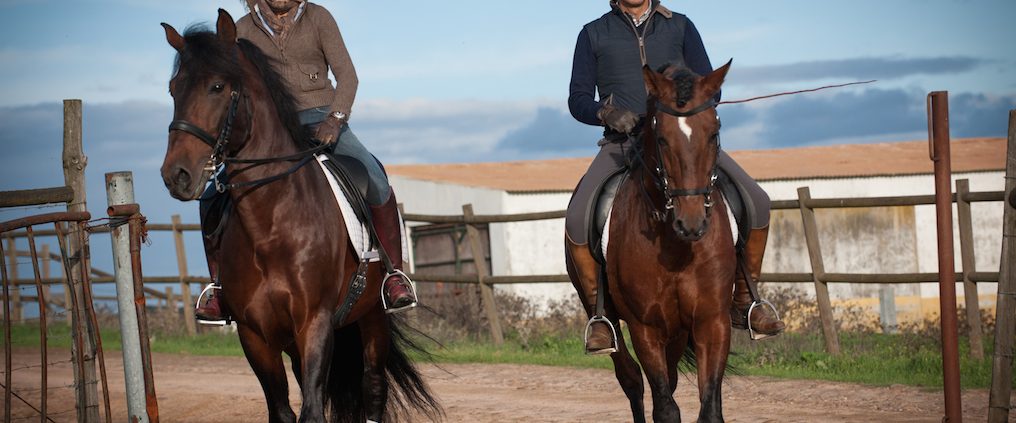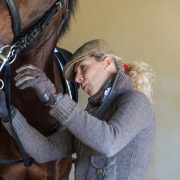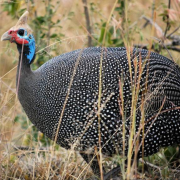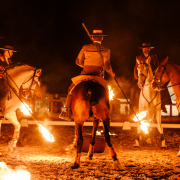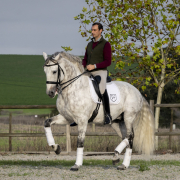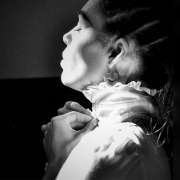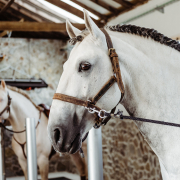Interview With Paulo & Maria Caetano

The Most Dynamic Duo
With the ‘hot topic’ debates about modern day competition dressage and classical dressage on so many lips I cannot think of a greater example of this in action than the dynamic duo of Paulo Caetano and his daughter Maria. Two people who live and breathe traditional classical and modern day dressage.
Recently I paid a visit to my friends Paulo and Maria to gain more insight into their lives.
Their home is in the Alentejo, Portugal close to the Spanish border. A long drive takes you up to one of their stunning farms, where the Lusitano horses are bred and trained. The landscape is a timeless scene of rolling hills, lakes, clusters of trees, wild flowers and everywhere is teaming with bird life. Cattle and horses graze contentedly on the lush grass unusual for this time of year, but there has been more rain than normal. The drive winds it’s way to the farm, made up of a house, stables, indoor and outdoor arenas and a breeding facility situated in the middle of the expansive Alentejo views.
When Lena and I arrived we found Maria busy with her sponsors trying out new Bates saddles on her competition horses. I reflected it was only a few weeks before I saw her performing at the world equestrian games on her Lusitano stallion Xirpiti.
Trained by her father Maria is now one of Portugal’s leading stars in dressage competing Internationally. So what makes their story so special so unique?
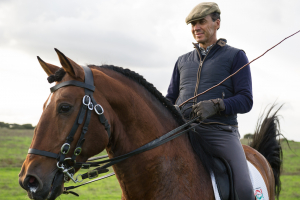
Paulo Caetano riding one of his bull fighting horses on the farm
Part 1 – Paulo Caetano – interview in 2014
Paulo Caetano is a man of great style, a warm smile and engaging manner. He was also one of Portugal’s most well known bull fighters. This year (2014) two riders he trained competed this year in the World Equestrian games in Caen France – his daughter Maria Caetano and Manuel Veiga.
A little bit of History
Paulo´s family were landowners and in 1972 when Portugal’s leader Salazar stepped down from power the army took over running the country in the form of a communist regimé, this situation lasted about 3 years. During this period the Communists aggressively took away the rich manor homes, estates and vast farms from the wealthy to be divided between the people. As a result the banks collapsed and moved their business out of the country. Paulo´s family were among those affected.
Paulo tell us a bit about your family history, childhood and also why did you choose to ride in the bull fight?
Yes both my grandfathers were farmers in Ribatejo and Estremadura regions of Portugal breeding cattle and the black bulls. My father an entrepreneur, worked in Lisbon. He was an amazing business man and a fantastic father. He always respected my dreams to be a rider supporting my decision to become a bullfighter. I was the first person in my family to choose this career.
In 1973 during the Revolution like many I left Portugal, I went to Badajoz in Spain. It was there that my bull fighting career rapidly developed. I made many great supportive friends – I’ll always be very grateful to Moreno Pidal, Alvaro Domeq, Angel Peralta , Fermin Bohorquez, Manuel Vidrié and Jacinto Alcon, all are my true friends for life.
In 1978, I came back to Portugal then my father handed me the responsibility of managing the Esquilas Farm at Monforte, which is still our family’s favourite place to this day.
Even with this new responsibility I continued my passion gaining a lot of success as professional bullfighter. The fights provided me with enough money to develop new agricultural and cattle businesses in our farms plus I bought more land. It was at this time I started breeding Lusitanos.
The Importance of Mentors
At the Monforte farm, my mentor was Antonio Moura, an expert in everything to do with agriculture and cattle. Antonio was the uncle of my college and competitor João Moura and father of the lovely Dita, my future wife.

Paulo and Dita
Meeting Dita has always stayed etched in my mind she used to drive a small scooter to the farm to watch me training. Every day she was in the manége, looking childlike, very quiet, unassuming, a bit shy, but gorgeous.
Two years later we were married and the year after my son João was born. Maria followed three years later. Dita and I have been extremely happily married now for thirty two years.
Paulo at what age did you start bull fighting and what made you choose this life?
I started riding horses at 4 years old and bullfighting professionally when I was 14. I don’t know about choosing it – it’s a passion that has always been in me right from the start.
When I was thirteen I left school and met Antonio Badajoz, one of the most important bullfighting personalities of the time. Although I was very shy I was determined, to say hello to him. To my joy he answered: how are you? Immediately
I replied: I am Paulo Caetano and I want to be bullfighter. Can you see me riding? He laughed, said yes, let´s go.
Three months later I had my first bullfight contract at Campelos – Torres Vedras Portugal 1974.
Paulo at what age did you start bull fighting and what made you choose this life?
I started riding horses at 4 years old and bullfighting professionally when I was 14. I don’t know about choosing it – it’s a passion that has always been in me right from the start.
When I was thirteen I left school and met Antonio Badajoz, one of the most important bullfighting personalities of the time. Although I was very shy I was determined, to say hello to him. To my joy he answered: how are you? Immediately
I replied: I am Paulo Caetano and I want to be bullfighter. Can you see me riding? He laughed, said yes, let´s go.
Three months later I had my first bullfight contract at Campelos – Torres Vedras Portugal 1974.
You mentioned that you had classical training masters that changed you who are they ?
Yes indeed. Concerning my masters I had been a very lucky guy. Antonio Badajoz taught me all about bullfighting the art and rules. He also taught me all the secrets about wild bulls – the Important details about their reactions in the fields and in the arena.
When it comes to the horses and classical equitation my first master, from the age of 4 was my uncle Fernando Metzner Serra. He had German equestrian origins which he openly he shared with me. Then the ones who taught me the fundamentals of classical equitation were the teachings of Pluvinel, Robichon de la Guerinière and Baucher. For me they were the unquestionable masters. I gained all my basic principles from these men.
Grand Classical Masters
My uncle was good friends with the Master of Masters João Branco Nuncio. João Nuncio and Nuno de Oliveira are the most important classical Equestrian`s icons in Portugal. I was very lucky to have the opportunity to go with my uncle Fernando to Vale de Lobos, Nuncio´s farm at Alcácer do Sal. I watched him riding fantastic horses like Ferrolho and Lord Mayor.
The Revelution
During the revolution, two good friends of my father, who lost their farms, came to live in Lisbon. The Viscount da Córte and his best friend and student João Parreira Cano,two very good classic dressage riders I trained with them everyday for 3 years in the classical method.
I’ve always had the desire to make sure I watched and ride with the great masters like Coronel João Martins Abrantes, João Lopes Aleixo and Francisco Cancela de Abreu. They are generous people that have been open and willing to share their knowledge. All of them have given to me knowledge in different ways, but most of all, all imparted the importance of respect and love with the horse.
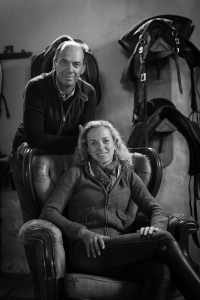
What do you remember most about your early training? Is there something that you always hold true now?
I have been blessed having the opportunity to have so many wise professors They gave me a good and solid base from which to build. Now, 40 years later, I can solve a problem thinking about one of them and their advice. But the most importantly I haven’t stop learning. I know everyday I can learn something new I like to think I am progressing I am not sure but I believe that I am getting better. Certainly each young horse that I start training reminds me : hey you , try to do less mistakes.
Have you any very special or funny memories you would like to share with the readers?
I have so many I don’t know where to start –
In the second Young riders European Championship where Maria was due to compete, her horse, a warm blood called White Cedar, and when he was already traveling to Austria a friend asked Maria to participate in a Prix St. George competition. Maria said to me: I have a problem I want to do this but I have no horse. I said don’t worry take one of my horses. She trained the Lusitano son of Neptuno a couple of days and performed a good PSG test. What people don’t know is that the day after I fought with that horse in a very important Corrida (bull fight). He was one of my best horses.
Maria
In 2006 Maria won the Iberic Cup of Dressage riding a beautiful black Lusitano called Sole Sombra. Fifteen days after, My son and I had one of the most important Corridas of the season. Campo Pequeno at Lisbon. Was the “Alternativa” of João – the day when he became professional. One of best horses went lame. So I started training Sole Sombra. It is a testament to the importance of classical equitation basics they were so good that in two weeks I had him ready for bullfighting. We did a great job in Campo Pequeno Lisbon. One month later I sold him to a dressage rider to Germany. What a horse!
1996 I fought alone 6 bulls bred by me, with Lusitano horses almost all bred by me, and all trained by me.
My Son Joao
In 2012 João follow my steps and fought alone 6 bulls at Monforte, with horses bred and trained by him. It was a very formal occasion and I was dressed in a formal suit. When the the 5th bull arrived João invited me to ride with him, and I did it! Dressed in a suit I rode my favourite horse. The public went crazy.
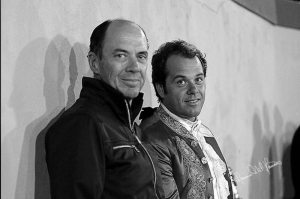 Paulo and his son Joao
Paulo and his son Joao
So Many Things make me Proud
I am very proud of two Lusitano horses bred and trained by me that were selected to the WEG at Kentucky : Util for Portuguese Team and Portugal for Brazilian Team.
I am over the moon with all the Portuguese Championships that Maria has won.
2014 has been a fantastic season for Maria and myself as trainer. She won The Portuguese Championship Gran Prix riding Xiripiti; The National Open Prix St George riding Coroado and the Masters Freestyle with Zingaro de la Lyra y la W. The three most important competitions with three different horses, all of them Lusitanos.
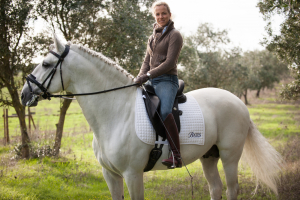
Two riders I trained have been selected to the Portuguese Team in WEG at Caen. My daughter riding Xiripiti and Manuel Veiga riding Benhur da Broa.
Another GP rider Maria Amaral also trained by me gained a really good result in Barcelona and then later won the silver in Open Portuguese Prix St George Championship.
Francisco Pimentel was first in Portuguese Cup Young Horses ( 4YO) riding the beautiful Esquadra MV which is now with my friend and fantastic rider José G Mena.
And all my successful students around the world make me very proud everyday.
Paulo you have two talented children that both love horses and have chosen their careers to be riding. This must be a great pleasure for you. You coach them both in their professional careers – bullfighting and competition dressage. Both are achieving at a high level.
I am very interested in the cross over with classical dressage and modern competition and it seems there is a full circle happening with riders globally looking more closely at the roots of classical equitation. I think you are a fantastic example of crossing the boundaries of classical and modern indeed to coach to people to the WEG is an exceptional achievement especially since you are a bull fighter. Can you talk an bit about how you find the cross over….
To answer this question I think it is fundamental to understand, the history of the Lusitano (Iberian) horse and how Portuguese equitation has evolved. The Iberian horses are very important in our history because it is their functionality that made them very versatile companions, these horses influenced the way forward in our civilization. They started as great war horses offering us amazing combat skills in their agility and ability for collection to produce powerful movements (tricks). Then, later when war was over classical equitation grew from the skills developed in combat. If you assimilate the classical equitation doctrine practised since the “Haute Renaissance” to the Saumur (France), Belém (Portugal), Viena (Austria) and Jerez ( España) you will see the principles. I think it is also very valuable to understand the influence of the German masters too, they were making the bridge between the gymnastic of the horse and the importance of the development of the horse´s body and mind following a intelligent structured method.
Then, it is important to understand and integrate the interaction of the training scales, classical principles and how important is the riders influence on the horse. I feel the training scales act as the bridge between classical and modern. When it comes to classical and modern dressage the basics are the same, although professional dressage training or a professional bullfight training have some very different requirements, different things to achieve, the basics don’t change.
In sport you have to follow a strict development program to build the physical capacities of your horse. It is very important to respect and understand his limits in order to help him achieve the best he can. The sport horse is not a pet. It is an athlete and you must be responsible for his improvement and to stay healthy. To achieve the goal, you have to have a very good eye, to have the capacity to anticipate reactions, the discipline to follow the right way but, mainly, to know which the right way is.
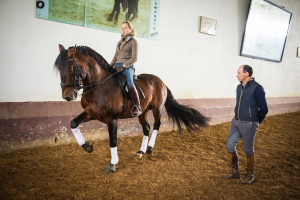
Watching the Master at Work
I noticed when watching you and Maria riding the same horse in the same movements an interesting difference in the horse. The horse worked beautifully and willing with both of you but the level of dynamic is different – not negative just different I am sure anyone can say this of any two riders riding the same horse. However I feel there is another level of difference. As a top bull fight horseman you have amazing skills that are the requirements of such an art, because lets face it when you are in the arena a mistake can cost you and your horse dearly. Most the riding is one handed and often using highly skilled quick lateral movements your seat and thighs are very powerful it is difficult to see anything happening but the horse responds with such a high level of understanding and remains totally in tune with you. A certain level of tension is required is in fact essential this is transmitted from the rider’s body to the horse creating a dynamic connection.
It is fantastic to watch!
I realise bull fighting is a sensitive subject for many and I have no interest in delving into these arguments there are plenty of forums online available for this debate. My interest is in the skills, the art, the horse/rider communication and the classical principles you use. I fully appreciate that is it bull fighting that has meant the Lusitano breed is as fabulous and talented as it is. The bull fighting tradition has ensured Lusitano has survived and is now a breed highly appreciated world wide…. it is people such as yourself that have maintained the horse’s future we thank you for this.
Of course it is not quite the same in dressage competition….. although I am certain some would say the same of the judges it feels like a matter of life or death :-). The riding has some different requirements such as in the contact, the horse’s outline, the walk, extensions etc. Can you talk a bit about how you have managed to cope with all this and what you feel are the most important aspects classical brings to modern competition.
In thanks
Thank you very much Teresa for your kind words. I do my best every day, trying to make less mistakes and always aiming to be the best partner to my horse. I am truly happy with the extraordinary evolution of Lusitano. I believe that we have some of the best horses in the world. I believe that in the near future we will arrive on the podiums in the main international competitions. But the most important thing is to understand the reasons why Lusitano is such a fantastic horse. The main reason is in breeding choices is having the capacity to imagine, to create and to breed a brave, functional horse able to make his rider happy, and be a happy horse as well.
In my opinion in modern competition the most vital classical aspects are the importance of beauty, lightness and harmony. We must keep this.
To ride a horse making invasive movements towards a wild bull who is attacking you, is truly special. The flexibility, the impulsion, the confidence, the collection, all these fundamentals are there. Equitation as a vital function, able to defend your life. It is an incredible feeling as rider. To know, without reservations, that your horse is as a true partner completely with you. When we taste this emotion nothing else can compare. Bullfighting has been through many different times. In 70´s and 80´s in Portugal a good bullfighter was so famous they were like Cristiano Ronaldo is now.
When you get inside this extraordinary world you forget all the rest. If you can read Hemingway, Camilo Cela, Vargas Losa or Garcia Marquez then you can understand it better.
On the subject of opinions about bullfighting, I don’t know. I am comfortable with my career, my challenges , my future goals , my horses, the riders training with me. My family respect and love horses. We love our job. About the future only God knows.
We all are blessed people. Nowadays, we can see the best horses, the best riders and the best judges ever.
You have a fabulous estate in the Alentejo and you still breed the black bulls and lusitano horses. Do you still mostly compete with your own home bred horses? How much has Maria going into competition dressage influenced your horse breeding decisions? What bloodlines do you use?
To compete with horses bred by us is a permanent and extraordinary objective.
I am very proud that now I have the three best Lusitanos bred by me: three 4 year olds – Flamenco, Fogo and Falcão. Amazing horses. I am very motivated by them. My first concern in producing good GP horses is the power, the strength, good character and generosity in spirit.
I know my mares very well. Concerning the stallions, I always go to horses that give me high results and scores. Because this is the best proof of their quality.
Stallions – I love Altivo ( PC), Neptuno ( Veiga), Hostil ( G Borba) and Qualificado ( Coimbra) bloodlines. Rubi can be a good option and Coroado his son is becoming a star.
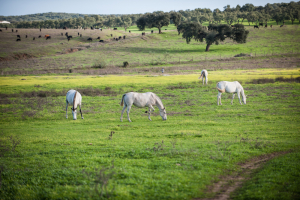
I am sure you and Maria are aiming for the Olympics and we would very much like to see you there. What other plans, goals do you have?
Next goal is the European at Haacchen. In 2015 we´ll have three horses in GP: Xiripiti, Zingaro andCoroado. We also have some exciting new cards to play very soon. So our first goal is to work hard and then try to deserve to be in the best competitions.
Thank you Paulo always a pleasure to spend time you and your family.
Click here to read Part two with Maria Caetano
Text by Teresa Burton and Images by Lena Saugen Photograhy
